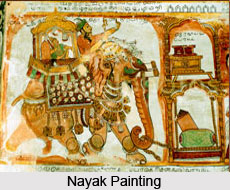 Nayak paintings are part of the popular Tanjore paintings. The Nayaks were great temple builders and they were in power in Tanjore as the deputies of Vijayanagara rulers. As far as their architecture and painting are concerned they drew their inspiration from the several monuments built by the Vijayanagar Empire. Thus the Nayak paintings mirror the style and standard of Hampi. The instances of Nayak paintings are to be found on the temples of Thanjavur. The paintings at Tiruvalanchuzi, Thiruvellarai, Tiruvalur and Pattiswaram are some of the finest examples of Nayak paintings that were inspired by those belonging to Vijayanagara.
Nayak paintings are part of the popular Tanjore paintings. The Nayaks were great temple builders and they were in power in Tanjore as the deputies of Vijayanagara rulers. As far as their architecture and painting are concerned they drew their inspiration from the several monuments built by the Vijayanagar Empire. Thus the Nayak paintings mirror the style and standard of Hampi. The instances of Nayak paintings are to be found on the temples of Thanjavur. The paintings at Tiruvalanchuzi, Thiruvellarai, Tiruvalur and Pattiswaram are some of the finest examples of Nayak paintings that were inspired by those belonging to Vijayanagara.
Following the traditions of the Nayak paintings it is seen that the artists have painted over the already existing Chola murals and unintentionally they have ended up preserving them. Nayak paintings flourishing under the Vijayaraghava Nayak are also found in Brihadeeswarar Temple. They are in the same corridor as the Chola paintings. The themes are Shaivite but the method and styles are very different and they reflect the changes in the patronage of arts. The stories include the Samudra manthan and the life of Saint Kanappa, who offered both his eyes to Lord Shiva. One of the paintings even bears the signature of the artist.
However the Nayak paintings differ in the style of fresco from that of the Cholas. Their frescos have less emphasis on details and demands less expertise from the painter. Folk elements were conspicuous in Nayak paintings. Bright thick colours were generously used and the figures were portrayed in stiff formal styles. The paintings were quickly done with no attention to shading and realism. The figures were often two dimensional and images and motifs used resembled those in the textiles for sarees and other apparels. No attempt was made on modelling. Besides these, Nayak paintings were also found on manuscripts and followed the same pattern. Illustrations of such paintings still exist though they are a damaged version.



















